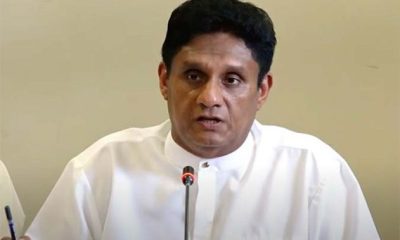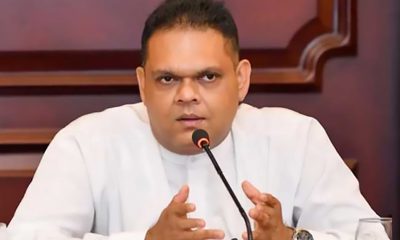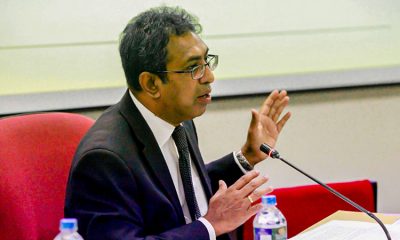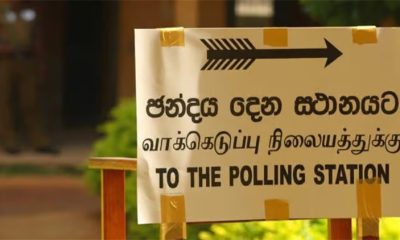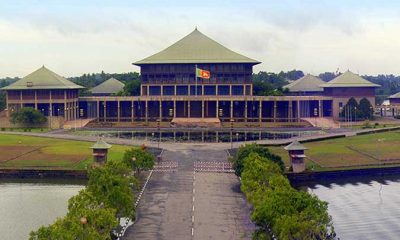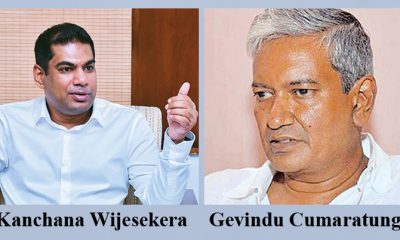Features
Election ’24: Hopes for Constitutional Reforms are still alive
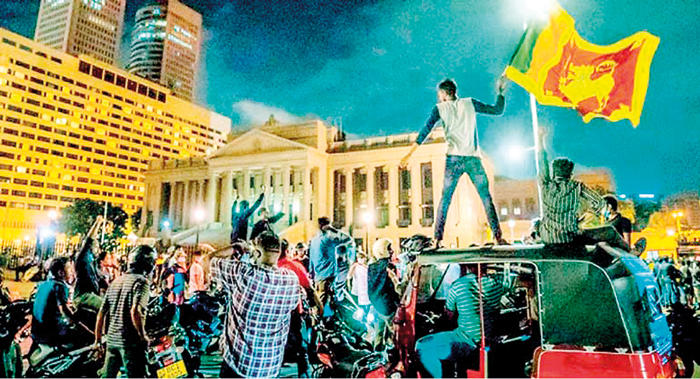
by Rajan Philips
The Collective for Democracy and Rule of Law (CDRL) is making a commendable intervention to launch a platform for constitutional reform early on in this election year. The Collective has convened a meeting of civil society activists and organizations, and a well-attended meeting was held in Colombo on Wednesday (January 24) last week. My focus today is on the discussion document that was circulated in advance and discussed at the meeting.
It is a refreshingly short document of 11+ pages, entitled “Principles and Proposals for Political and Constitutional Reform,” which underscores the work done by the Collective members over 30 years in preparing multiple drafts for constitutional reform. This long work without commensurate results due to ill-equipped and constitutionally less than literate political leaders, has led to constitutional overthinking in Colombo political circles. The new document is mostly free of overthinking but not totally without its hangover. At the same time, the results of their efforts have not been insignificant. To wit, the 17th Amendment and the 19th Amendment to the constitution, even though they were generally frustrated by the vexatious (18th and 20th) Amendments) of the Rajapaksas.
Thanks to Aragalaya, the country was spared of what could have been a disastrous overhaul of the constitution under Gotabaya Rajapaksa, the most constitutionally illiterate person ever to hold high offices in the Sri Lankan state. The legacy of Aragalaya is evoked in the invitation for Wednesday’s meeting, inasmuch as it was an expression of desire with new ideas among Sri Lankan citizens for a “deepening democratization” of the state. The new ideas of public trust, accountability and meaningful participation are what inform the “Principles and Proposals for Political and Constitutional Reform,” and what the proposals for reform are seeking to achieve.
Parliament and Presidency
Fundamental to these changes is the restoration of parliamentary democracy, and the new proposals seem keen to frame the debate by emphasizing the restorative aspect as the primary reform goal and the abolition of the executive presidency as its inevitable adjunct. The most readily implementable part of the new proposals is the electoral reform which is also crucial to restoring parliamentary democracy. The proposals provide for a bicameral legislature comprising a House of Representatives of 200 members and a Senate of 50 members.
Of the 200 members of the House, 130 are to be elected from the old-style territorial constituencies and the simple first-past-the-post system. 60 members are to be allocated to political parties based on proportional representation according to their voting tallies either at the national level or provincial level. The remaining 10 seats are to be allocated to political parties who contested the election but have no representation among the 190 members. These seats will be allocated to them in proportion to their national vote.
The proposals indicate that appropriate provisions will be made to ensure adequate representation of women, youth and underrepresented interest groups. Including women with youth and interest groups for appropriate consideration is simply not acceptable. The 60 proportional representation seats could easily be, and in fact should be, all allocated to women, which would be similar to constitutional arrangements in Bangladesh and in Pakistan.
Although the electoral reform is part of a complete reform package, there is no reason why these changes cannot be implemented by the current parliament, to be in place for the next parliamentary election.
That is not a task for the Collective for Democracy and Rule of Law, but the Collective could certainly build public and media pressure to bear on the political parties in parliament and on the aspiring presidential candidates.
If the question of implementing electoral reform here and now were to be put to Anura Kumara Dissanayake, Sajith Premadasa, or His Excellency, President Wickremesinghe, will they risk rejecting it? We will not know unless someone asks them.
While at it, why not add the amendment to change the system of electing the Head of State?
The new proposal is to have the President (and a Vice President) elected by an electoral college comprising members of the House of Representatives and the Senate. We will get to the Senate later, but why not have an amendment now by the current parliament that would end the system of direct election and provide for the new parliament to elect the next president as the Head of State but not the Head of Government.
Why go through the trouble and expense of a direct presidential election in September-October if it is going to be the last such election?
Again, it is up to the will of the political leadership and it is not a question of whether or not it can be done. The two changes are certainly doable by the current parliament. They are also implementable within the framework of the current constitution. I cannot see any one of the three presidential candidates publicly rejecting these possibilities if they were put to them in a public forum. Ideally, having all of them together at the same forum.
Vice President
Another proposed change is to have a Vice President, which would be an interesting addition to have even after the presidential system is emasculated. It would also be a striking contrast to President Jayewardene ruling out a Vee Pee for him while implementing a full throttled presidential system. His reasons of course were perversely negative – to avoid a political shootout among his second rung ministers to climb the Vee Pee pole. The top guns were all plotting to succeed JR Jayewardene.
The motivation now to have a Vice President is positively different – for the purpose of “sharing higher-level political office between ethnic communities” as part of transforming Sri Lanka into “a multi-ethnic and pluralist democracy.” The Vice President is stipulated to be someone from a community other than the community to which the President belongs.
There are enough examples from India where the President and the Vice President have been elected by an electoral college and have provided symbolic representation to India’s vastly diverse communities and groups. There will be no coming of age celebrations for Sri Lanka as a modern republican democracy until any and all high posts are equally open to all of its citizens regardless of their ethnic identity. Until then, small steps like the vice presidential positions should be welcome as notable progress.
The Senate
The old senate that was brusquely brushed away even while the Soulbury Constitution was breathing its last, is now back but with a different structure and for wholly different reasons. One would think that that it will not be, to reverse Jennings as well as Colvin, either superfluous by being rubber stamp to the House or mischievous by frustrating the will of the people. Rather, the new Senate could look for its model in what the founders of the US Senate (mostly James Madison) intended it to be – a mature, cautious, competent and deliberative body of sober second thought. And not what the US Senate, and more so the Congress, are turning out to be under the onslaughts of Trump’s Republican Party.
The new Senate is intended to be an institution for power sharing by ensuring provincial representation, in addition to being a check on the legislative overreach of the House of Representatives.
The Senate is proposed to have 50 members, with each Provincial Council electing five members, at least two of them women; and five members appointed by the President to represent unrepresented or underrepresented interests.
The 45 provincial members are to be elected on the basis of proportional representation within each provincial council, and the five presidential appointees are to be nominated by the Prime Minister and the Leader of the Opposition in the House of Representatives.
All Senators are expected to be drawn from those “who have distinguished themselves in public life.” This qualification is too vague and will not be enough if the Senate is to play the role that is expected of it. The minimum age must be much higher than what it is for a voter or to become an MP. It will not hurt to require educational qualifications along with alternative experiential qualifications. There is no point in having a Senate if it is going to end up with the same calibre of MPs as there are in today’s parliament.
The proposal would seem to provide for all bills to be presented to the Senate for review and feedback, but not to vote on. The exceptions would be bills that may have implications for provincial powers, and they will require passage in the Senate with at least two members from each province voting in favour. This is the intended safeguard for provincial powers and functions from being diluted or usurped by the central government. Finally, the Senate will have the same role as the House in Constitutional Amendments – with two-thirds majority required both in the House and the Senate. No more referendums!
Balance of Powers
Besides electoral reforms, reconstituting the balance of power between the President and Parliament is a key requirement for restoring parliamentary democracy. The abolishing of the executive presidency by itself is a major part of restoration. But before Sri Lanka came under presidential tyranny it had a trial run under parliamentary tyranny. The new proposals are alert to avoiding that.
A number of provisions are being suggested – the Senate as already discussed, restricting cabinet size, establishing a Constitutional Council, and judicial review of legislation and administrative actions along with the return of the Constitutional Court, are the main ones. On a not unrelated note, there is some significance given to the matter of handling cross-over MPs.
In what seems to be an anomaly, the President is identified as the “repository of the executive power of the people,” even after restoring parliamentary democracy. This seems to be textual hangover from the JRJ constitution, while the Prime Minister as the Head of Government, and the government is going to be good old Cabinet Government. What is the purpose in identifying a “repository of the executive power” in the constitution that is outside the cabinet government?
The executive power in any event will be exercised by the Cabinet of Ministers who will in the restored order be answerable only to parliament and not any higher executive. At the same time the cabinet is cut to size literally by the proposal to limit the number of ministers to 20 and the number of state ministers also to 20. DS Senanayake wanted such a limitation in the Soulbury Constitution but the British advised against it.
Interestingly, at least five of the 20 ministers ought to be women, and at least another five ought to belong to communities other than the majority community. Shades of fifty-fifty, you would think. Similar distribution is also proposed for state ministers. These are laudably inclusive measures.
The idea and the institution of a Constitutional Council is recognized as being the outcome of “civil society pressure to curb the excessive powers of the executive presidency and to depoliticize the state and public service … (and) to function as a system of checks and balances to curb governmental power.” The same institution is proposed to be retained even after parliamentary democracy is restored, because “it could serve as an instrument for achieving a national consensus on high-level appointments.”
There should be second thoughts on the Constitutional Council as the idea of having another constitutional layer seems superfluous especially after getting rid of the executive presidency and bringing in a Senate comprising distinguished citizens. What is that we need a Constitutional Council (CC) for that cannot be done by the Senate or its Committees, even joint Committees with MPs?
Four of the 10 CC members are already members of the House or the Senate. The other six members or comparable alternates could be elected as Senators. Is there a need for another body to accommodate five distinguished citizens for their wise counsel when they can be easily accommodated in the Senate? At most, a Constitutional Council can play a fixed-term role until all the constitutional changes are implemented and the Senate is established and functioning. At that point the Council could be terminated.
(To be continued)
Features
The heart-friendly health minister

by Dr Gotabhya Ranasinghe
Senior Consultant Cardiologist
National Hospital Sri Lanka
When we sought a meeting with Hon Dr. Ramesh Pathirana, Minister of Health, he graciously cleared his busy schedule to accommodate us. Renowned for his attentive listening and deep understanding, Minister Pathirana is dedicated to advancing the health sector. His openness and transparency exemplify the qualities of an exemplary politician and minister.
Dr. Palitha Mahipala, the current Health Secretary, demonstrates both commendable enthusiasm and unwavering support. This combination of attributes makes him a highly compatible colleague for the esteemed Minister of Health.
Our discussion centered on a project that has been in the works for the past 30 years, one that no other minister had managed to advance.
Minister Pathirana, however, recognized the project’s significance and its potential to revolutionize care for heart patients.
The project involves the construction of a state-of-the-art facility at the premises of the National Hospital Colombo. The project’s location within the premises of the National Hospital underscores its importance and relevance to the healthcare infrastructure of the nation.
This facility will include a cardiology building and a tertiary care center, equipped with the latest technology to handle and treat all types of heart-related conditions and surgeries.
Securing funding was a major milestone for this initiative. Minister Pathirana successfully obtained approval for a $40 billion loan from the Asian Development Bank. With the funding in place, the foundation stone is scheduled to be laid in September this year, and construction will begin in January 2025.
This project guarantees a consistent and uninterrupted supply of stents and related medications for heart patients. As a result, patients will have timely access to essential medical supplies during their treatment and recovery. By securing these critical resources, the project aims to enhance patient outcomes, minimize treatment delays, and maintain the highest standards of cardiac care.
Upon its fruition, this monumental building will serve as a beacon of hope and healing, symbolizing the unwavering dedication to improving patient outcomes and fostering a healthier society.We anticipate a future marked by significant progress and positive outcomes in Sri Lanka’s cardiovascular treatment landscape within the foreseeable timeframe.
Features
A LOVING TRIBUTE TO JESUIT FR. ALOYSIUS PIERIS ON HIS 90th BIRTHDAY

by Fr. Emmanuel Fernando, OMI
Jesuit Fr. Aloysius Pieris (affectionately called Fr. Aloy) celebrated his 90th birthday on April 9, 2024 and I, as the editor of our Oblate Journal, THE MISSIONARY OBLATE had gone to press by that time. Immediately I decided to publish an article, appreciating the untiring selfless services he continues to offer for inter-Faith dialogue, the renewal of the Catholic Church, his concern for the poor and the suffering Sri Lankan masses and to me, the present writer.
It was in 1988, when I was appointed Director of the Oblate Scholastics at Ampitiya by the then Oblate Provincial Fr. Anselm Silva, that I came to know Fr. Aloy more closely. Knowing well his expertise in matters spiritual, theological, Indological and pastoral, and with the collaborative spirit of my companion-formators, our Oblate Scholastics were sent to Tulana, the Research and Encounter Centre, Kelaniya, of which he is the Founder-Director, for ‘exposure-programmes’ on matters spiritual, biblical, theological and pastoral. Some of these dimensions according to my view and that of my companion-formators, were not available at the National Seminary, Ampitiya.
Ever since that time, our Oblate formators/ accompaniers at the Oblate Scholasticate, Ampitiya , have continued to send our Oblate Scholastics to Tulana Centre for deepening their insights and convictions regarding matters needed to serve the people in today’s context. Fr. Aloy also had tried very enthusiastically with the Oblate team headed by Frs. Oswald Firth and Clement Waidyasekara to begin a Theologate, directed by the Religious Congregations in Sri Lanka, for the contextual formation/ accompaniment of their members. It should very well be a desired goal of the Leaders / Provincials of the Religious Congregations.
Besides being a formator/accompanier at the Oblate Scholasticate, I was entrusted also with the task of editing and publishing our Oblate journal, ‘The Missionary Oblate’. To maintain the quality of the journal I continue to depend on Fr. Aloy for his thought-provoking and stimulating articles on Biblical Spirituality, Biblical Theology and Ecclesiology. I am very grateful to him for his generous assistance. Of late, his writings on renewal of the Church, initiated by Pope St. John XX111 and continued by Pope Francis through the Synodal path, published in our Oblate journal, enable our readers to focus their attention also on the needed renewal in the Catholic Church in Sri Lanka. Fr. Aloy appreciated very much the Synodal path adopted by the Jesuit Pope Francis for the renewal of the Church, rooted very much on prayerful discernment. In my Religious and presbyteral life, Fr.Aloy continues to be my spiritual animator / guide and ongoing formator / acccompanier.
Fr. Aloysius Pieris, BA Hons (Lond), LPh (SHC, India), STL (PFT, Naples), PhD (SLU/VC), ThD (Tilburg), D.Ltt (KU), has been one of the eminent Asian theologians well recognized internationally and one who has lectured and held visiting chairs in many universities both in the West and in the East. Many members of Religious Congregations from Asian countries have benefited from his lectures and guidance in the East Asian Pastoral Institute (EAPI) in Manila, Philippines. He had been a Theologian consulted by the Federation of Asian Bishops’ Conferences for many years. During his professorship at the Gregorian University in Rome, he was called to be a member of a special group of advisers on other religions consulted by Pope Paul VI.
Fr. Aloy is the author of more than 30 books and well over 500 Research Papers. Some of his books and articles have been translated and published in several countries. Among those books, one can find the following: 1) The Genesis of an Asian Theology of Liberation (An Autobiographical Excursus on the Art of Theologising in Asia, 2) An Asian Theology of Liberation, 3) Providential Timeliness of Vatican 11 (a long-overdue halt to a scandalous millennium, 4) Give Vatican 11 a chance, 5) Leadership in the Church, 6) Relishing our faith in working for justice (Themes for study and discussion), 7) A Message meant mainly, not exclusively for Jesuits (Background information necessary for helping Francis renew the Church), 8) Lent in Lanka (Reflections and Resolutions, 9) Love meets wisdom (A Christian Experience of Buddhism, 10) Fire and Water 11) God’s Reign for God’s poor, 12) Our Unhiddden Agenda (How we Jesuits work, pray and form our men). He is also the Editor of two journals, Vagdevi, Journal of Religious Reflection and Dialogue, New Series.
Fr. Aloy has a BA in Pali and Sanskrit from the University of London and a Ph.D in Buddhist Philosophy from the University of Sri Lankan, Vidyodaya Campus. On Nov. 23, 2019, he was awarded the prestigious honorary Doctorate of Literature (D.Litt) by the Chancellor of the University of Kelaniya, the Most Venerable Welamitiyawe Dharmakirthi Sri Kusala Dhamma Thera.
Fr. Aloy continues to be a promoter of Gospel values and virtues. Justice as a constitutive dimension of love and social concern for the downtrodden masses are very much noted in his life and work. He had very much appreciated the commitment of the late Fr. Joseph (Joe) Fernando, the National Director of the Social and Economic Centre (SEDEC) for the poor.
In Sri Lanka, a few religious Congregations – the Good Shepherd Sisters, the Christian Brothers, the Marist Brothers and the Oblates – have invited him to animate their members especially during their Provincial Congresses, Chapters and International Conferences. The mainline Christian Churches also have sought his advice and followed his seminars. I, for one, regret very much, that the Sri Lankan authorities of the Catholic Church –today’s Hierarchy—- have not sought Fr.
Aloy’s expertise for the renewal of the Catholic Church in Sri Lanka and thus have not benefited from the immense store of wisdom and insight that he can offer to our local Church while the Sri Lankan bishops who governed the Catholic church in the immediate aftermath of the Second Vatican Council (Edmund Fernando OMI, Anthony de Saram, Leo Nanayakkara OSB, Frank Marcus Fernando, Paul Perera,) visited him and consulted him on many matters. Among the Tamil Bishops, Bishop Rayappu Joseph was keeping close contact with him and Bishop J. Deogupillai hosted him and his team visiting him after the horrible Black July massacre of Tamils.
Features
A fairy tale, success or debacle

Sri Lanka-Singapore Free Trade Agreement
By Gomi Senadhira
senadhiragomi@gmail.com
“You might tell fairy tales, but the progress of a country cannot be achieved through such narratives. A country cannot be developed by making false promises. The country moved backward because of the electoral promises made by political parties throughout time. We have witnessed that the ultimate result of this is the country becoming bankrupt. Unfortunately, many segments of the population have not come to realize this yet.” – President Ranil Wickremesinghe, 2024 Budget speech
Any Sri Lankan would agree with the above words of President Wickremesinghe on the false promises our politicians and officials make and the fairy tales they narrate which bankrupted this country. So, to understand this, let’s look at one such fairy tale with lots of false promises; Ranil Wickremesinghe’s greatest achievement in the area of international trade and investment promotion during the Yahapalana period, Sri Lanka-Singapore Free Trade Agreement (SLSFTA).
It is appropriate and timely to do it now as Finance Minister Wickremesinghe has just presented to parliament a bill on the National Policy on Economic Transformation which includes the establishment of an Office for International Trade and the Sri Lanka Institute of Economics and International Trade.
Was SLSFTA a “Cleverly negotiated Free Trade Agreement” as stated by the (former) Minister of Development Strategies and International Trade Malik Samarawickrama during the Parliamentary Debate on the SLSFTA in July 2018, or a colossal blunder covered up with lies, false promises, and fairy tales? After SLSFTA was signed there were a number of fairy tales published on this agreement by the Ministry of Development Strategies and International, Institute of Policy Studies, and others.
However, for this article, I would like to limit my comments to the speech by Minister Samarawickrama during the Parliamentary Debate, and the two most important areas in the agreement which were covered up with lies, fairy tales, and false promises, namely: revenue loss for Sri Lanka and Investment from Singapore. On the other important area, “Waste products dumping” I do not want to comment here as I have written extensively on the issue.
1. The revenue loss
During the Parliamentary Debate in July 2018, Minister Samarawickrama stated “…. let me reiterate that this FTA with Singapore has been very cleverly negotiated by us…. The liberalisation programme under this FTA has been carefully designed to have the least impact on domestic industry and revenue collection. We have included all revenue sensitive items in the negative list of items which will not be subject to removal of tariff. Therefore, 97.8% revenue from Customs duty is protected. Our tariff liberalisation will take place over a period of 12-15 years! In fact, the revenue earned through tariffs on goods imported from Singapore last year was Rs. 35 billion.
The revenue loss for over the next 15 years due to the FTA is only Rs. 733 million– which when annualised, on average, is just Rs. 51 million. That is just 0.14% per year! So anyone who claims the Singapore FTA causes revenue loss to the Government cannot do basic arithmetic! Mr. Speaker, in conclusion, I call on my fellow members of this House – don’t mislead the public with baseless criticism that is not grounded in facts. Don’t look at petty politics and use these issues for your own political survival.”
I was surprised to read the minister’s speech because an article published in January 2018 in “The Straits Times“, based on information released by the Singaporean Negotiators stated, “…. With the FTA, tariff savings for Singapore exports are estimated to hit $10 million annually“.
As the annual tariff savings (that is the revenue loss for Sri Lanka) calculated by the Singaporean Negotiators, Singaporean $ 10 million (Sri Lankan rupees 1,200 million in 2018) was way above the rupees’ 733 million revenue loss for 15 years estimated by the Sri Lankan negotiators, it was clear to any observer that one of the parties to the agreement had not done the basic arithmetic!
Six years later, according to a report published by “The Morning” newspaper, speaking at the Committee on Public Finance (COPF) on 7th May 2024, Mr Samarawickrama’s chief trade negotiator K.J. Weerasinghehad had admitted “…. that forecasted revenue loss for the Government of Sri Lanka through the Singapore FTA is Rs. 450 million in 2023 and Rs. 1.3 billion in 2024.”
If these numbers are correct, as tariff liberalisation under the SLSFTA has just started, we will pass Rs 2 billion very soon. Then, the question is how Sri Lanka’s trade negotiators made such a colossal blunder. Didn’t they do their basic arithmetic? If they didn’t know how to do basic arithmetic they should have at least done their basic readings. For example, the headline of the article published in The Straits Times in January 2018 was “Singapore, Sri Lanka sign FTA, annual savings of $10m expected”.
Anyway, as Sri Lanka’s chief negotiator reiterated at the COPF meeting that “…. since 99% of the tariffs in Singapore have zero rates of duty, Sri Lanka has agreed on 80% tariff liberalisation over a period of 15 years while expecting Singapore investments to address the imbalance in trade,” let’s turn towards investment.
Investment from Singapore
In July 2018, speaking during the Parliamentary Debate on the FTA this is what Minister Malik Samarawickrama stated on investment from Singapore, “Already, thanks to this FTA, in just the past two-and-a-half months since the agreement came into effect we have received a proposal from Singapore for investment amounting to $ 14.8 billion in an oil refinery for export of petroleum products. In addition, we have proposals for a steel manufacturing plant for exports ($ 1 billion investment), flour milling plant ($ 50 million), sugar refinery ($ 200 million). This adds up to more than $ 16.05 billion in the pipeline on these projects alone.
And all of these projects will create thousands of more jobs for our people. In principle approval has already been granted by the BOI and the investors are awaiting the release of land the environmental approvals to commence the project.
I request the Opposition and those with vested interests to change their narrow-minded thinking and join us to develop our country. We must always look at what is best for the whole community, not just the few who may oppose. We owe it to our people to courageously take decisions that will change their lives for the better.”
According to the media report I quoted earlier, speaking at the Committee on Public Finance (COPF) Chief Negotiator Weerasinghe has admitted that Sri Lanka was not happy with overall Singapore investments that have come in the past few years in return for the trade liberalisation under the Singapore-Sri Lanka Free Trade Agreement. He has added that between 2021 and 2023 the total investment from Singapore had been around $162 million!
What happened to those projects worth $16 billion negotiated, thanks to the SLSFTA, in just the two-and-a-half months after the agreement came into effect and approved by the BOI? I do not know about the steel manufacturing plant for exports ($ 1 billion investment), flour milling plant ($ 50 million) and sugar refinery ($ 200 million).
However, story of the multibillion-dollar investment in the Petroleum Refinery unfolded in a manner that would qualify it as the best fairy tale with false promises presented by our politicians and the officials, prior to 2019 elections.
Though many Sri Lankans got to know, through the media which repeatedly highlighted a plethora of issues surrounding the project and the questionable credentials of the Singaporean investor, the construction work on the Mirrijiwela Oil Refinery along with the cement factory began on the24th of March 2019 with a bang and Minister Ranil Wickremesinghe and his ministers along with the foreign and local dignitaries laid the foundation stones.
That was few months before the 2019 Presidential elections. Inaugurating the construction work Prime Minister Ranil Wickremesinghe said the projects will create thousands of job opportunities in the area and surrounding districts.
The oil refinery, which was to be built over 200 acres of land, with the capacity to refine 200,000 barrels of crude oil per day, was to generate US$7 billion of exports and create 1,500 direct and 3,000 indirect jobs. The construction of the refinery was to be completed in 44 months. Four years later, in August 2023 the Cabinet of Ministers approved the proposal presented by President Ranil Wickremesinghe to cancel the agreement with the investors of the refinery as the project has not been implemented! Can they explain to the country how much money was wasted to produce that fairy tale?
It is obvious that the President, ministers, and officials had made huge blunders and had deliberately misled the public and the parliament on the revenue loss and potential investment from SLSFTA with fairy tales and false promises.
As the president himself said, a country cannot be developed by making false promises or with fairy tales and these false promises and fairy tales had bankrupted the country. “Unfortunately, many segments of the population have not come to realize this yet”.
(The writer, a specialist and an activist on trade and development issues . )


